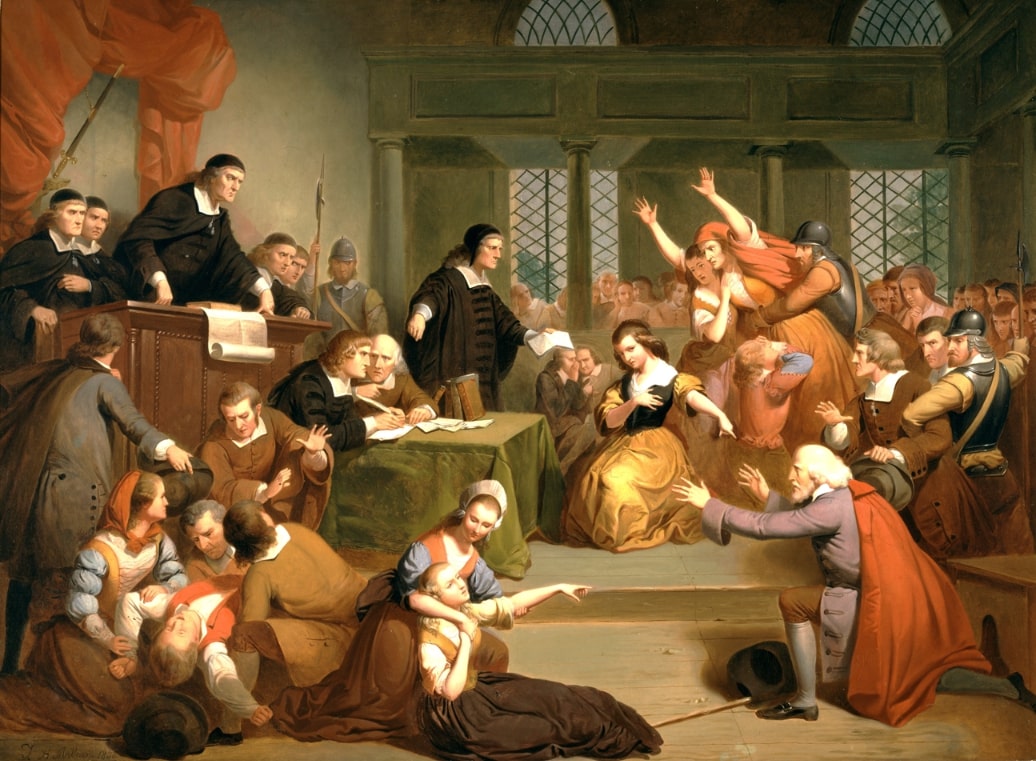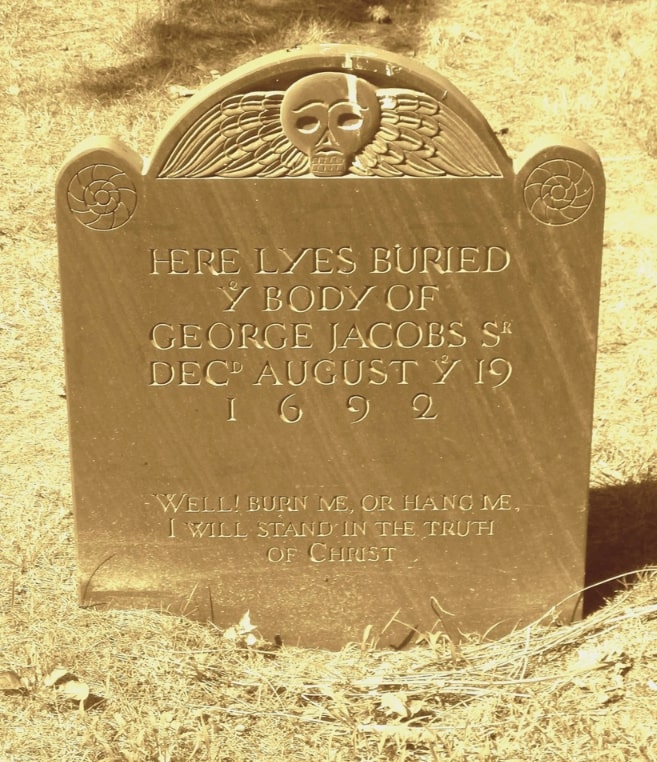Introduction: In this article, Melissa Davenport Berry writes more about the Salem witch trials of 1692, focusing on the case of George Jacobs. Melissa is a genealogist who has a blog, AnceStory Archives, and a Facebook group, New England Family Genealogy and History.
“Well! Burn me, or hang me. I will stand in the truth of Christ.”
–George Jacobs (hanging victim of the Salem Witch Trials)
Today I continue with the relics of the Salem Witch Trials. Many of these objects can be viewed at the exhibition gallery at the Peabody Essex Museum (PEM) in Salem, Massachusetts. This year’s theme is “Salem Witch Trials: Restoring Justice,” running through November 26.
Since the early 1990s the PEM has displayed rare artifacts associated with the witchcraft delusion, a dark period in New England history.
There is a famous painting that immortalizes one of the victims, George Jacobs. It can be viewed at the PEM. It was painted in 1855 by Tompkins H. Matteson and was a gift of R. W. Ropes in 1859.

According to the PEM:
The painting depicts Jacobs, who is being consoled by his son, George. On the left of the painting is Chief Magistrate William Stoughton, who would later serve three terms as governor of Massachusetts. Jacobs’ principal accuser was his granddaughter [Margaret Jacobs], who implicated him in an attempt to save her own life. Jacobs’ daughter-in-law is the woman standing and being held back. She was thought to be mentally ill (brain tumor). John Hathorne, the judge hearing the accusation, is thought to be an ancestor of Nathaniel Hawthorne. He holds a book and points at Jacobs’ granddaughter as if challenging her to substantiate her earlier written statements. In the foreground are a girl and boy who are having fits, allegedly caused by Jacobs’ wizardry. The boy is unknown but the girl may be either Jacobs’ servant or accuser Ann Putnam Jr.
George Jacobs’ Walking Sticks
George Jacobs was accused of witchcraft by Mercy Lewis, Mary Walcot, Abigail Williams, Sarah Churchill, Anne Putnam, and others. To view the files online visit historian Margo Burn’s site A Guide to the Primary Resources of the Salem Witch Trials.

Above photo Courtesy of J.W. Ocker.
Jacobs is referenced in the testimonies of the “afflicted girls” as the “man with two staves.” The girls claimed that Jacobs used his walking sticks to beat and torture them as a “specter.”
Before the witch hysteria Jacobs had been brought into court in 1677 and “was fined upon his presentment for striking John Tompkins [purportedly using his walking sticks].” This incident may have been used against him or even provided suggestive means on how to accuse him during the witch trials.
John Waters and Steven Small, being allowed witness fees, testified on behalf of Tomkins:
John Waters aged thirty-five years, and Stephen Small, aged twenty years, deposed that they saw George Jacobs Sr. strike John Tomkins Jr. one blow, and if the latter had not held him by the arms, he would have struck him more, he being in such a passion. Sworn in court. Records and Files of the Quarterly Courts of Essex County, Massachusetts, pp. 292-293.
Grave Marker
George Jacobs was hanged for witchcraft on 19 August 1692 during the Salem Witch Trials. He was 83. Three hundred years later, what are presumed to be his remains were buried and given a gravestone on the grounds of the Rebecca Nurse Homestead in Danvers, Massachusetts.

Here is the event as covered in the Patriot Ledger newspaper.

This article reported:
Three centuries after George Jacobs was hanged on Gallows Hill amid the witchcraft hysteria that swept Salem, his remains have finally been laid to rest.
“Hopefully, he is now properly buried,” said Richard B. Trask, chairman of the Salem Village Witchcraft Tercentennial Committee in Danvers. “This was probably the first time any kind of service has ever been held over his remains.”
The grave of Jacobs marks the only known resting spot of any of the 20 victims of the witchcraft trials.
Two other victims, Rebecca Nurse and John Proctor, are believed to be buried somewhere on their homesteads in Danvers and Peabody, respectively. But the others were buried in an unmarked, mass grave.
Jacob’s remains, which had been displaced several times over the past three centuries, were lowered into a grave during a quiet, solemn ceremony Sunday at the cemetery at the Nurse homestead.
Much of the proof that the bones actually belonged to George Jacobs lies in the annals of the Jacobs family.
In May 1692, he was accused of being a witch and brought to the Salem Village Meeting House for examination. After his trial, he was found guilty and hanged along with four others on Aug. 19, 1692.
Trask said the Jacobs family is said to have taken the body from the gallows and buried it on his farm.
In the mid-19th century, after the Jacobs homestead had been sold and the land was being excavated for house lots in the 1950s, the bones were recovered and turned over to the Danvers Historical society.

Read more from Richard Trask: The Devil Hath Been Raised: A Documentary History of the Salem Village Witchcraft Outbreak of March 1692.
Explore over 330 years of newspapers and historical records in GenealogyBank. Discover your family story! Start a 7-Day Free Trial
Note on the header image: witchcraft trial at Salem Village. The central figure in this 1876 illustration of the courtroom is usually identified as Mary Walcott. Credit: Wikimedia Commons.
Related Articles:

I am a direct descendant of George Jacobs
Hi Lisa, I am glad this story reached you. Thank you for sharing.
I lived in Stoughton Hall at Harvard, named after the judge in this trial. It was built in 1805 using a public lottery, which was a common way for institutions, public and private, to raise funds.
Hi Ken, thanks for sharing. I know someone who is researching Stoughton and hopes to publish a book on him. I think he left his estate to all women — well, the parts that he did not donate.
I’m looking for information on Eliza Marble, wife of pirate Ned Low. She died in childbirth. Any ideas? Thanks, Alan
Hi Alan. Thanks for sharing. I will send you an email soon.